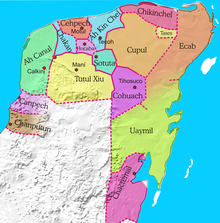Cupul
Cupul was a Principality ( Mayathan : kuchkabal ) of Maya on the Yucatan during the Postclassic that until the time of the Conquest had inventory.
Description and history
The Cupul jurisdiction borrowed its name from the ruling family of the same name. This is associated with the Maya Toltecs , as Náhuatl names predominate among them . The roots of the family can be traced back to Chichén Itzá , but it is unclear whether they belonged to the League of Mayapán , but this can be assumed. The province has its origin at the latest with the fall of Chichén Itzás or after the fall of Mayapán . Cupul had no central power in the 16th century, so was not ruled by a Halach Huinik , such as the friendly neighboring principalities of Cochuah , Sotuta or the hostile Ah Kin Chel . During the war, however, the entire military command was still with one Nacom . Of the approximately 35 larger towns in Cupul, the family that gave the name provided the Batab in around 15 . This was the highest secular office in times of peace and corresponded to a city prince or local governor. Cupul was one of the largest Mayan principalities and also the most populous. In the north it was bordered by Chikinchel, Tases and Ecab , which were also ruled only by Batabs. There was war with the former, while Cupul cooperated at least temporarily with Ecab. In the west, the territory possibly extended to Cobá . The Cupul are also associated with the founding of Bacalar , the capital of the later Principality of Uaymil, and other local foundations on the island of Cozumel .
Significant places in Cupul were Calotmul, Cenotillo, Chemax, Chichimila, Cucumul, Cuncunul, Dzitas, Dzitnub, Ebtún, Ek Balam , Espita, Kaua, Kikil, Kunuku, Nabalam, Panabá, Piste, Pixoy, Pocboch, Popola, Sodzil, Sodzil Sucopo, Tahcabo, Tahmuy, Tekom, Temozón, Tesoco, Tikuch, Tinum, Tixbaca, Tixcacalcupul, Tixualahtun, Tizimín , Tsonot, Tunkas, Uayma, Xocen, Xocenpich and Yalcoba.
In addition to the important ruins of Ek Balam, which were still inhabited after the Spanish conquest, Chichén Itzá was also on the territory of Cupul. There, too, important religious rituals were held until the Spanish period, the otherwise deserted metropolis was a supraregional pilgrimage center . In addition, the longest and most elaborate Sacbé Yucatáns ran right through Cupul , connecting Cobá with Yaxuná .
During the uprisings against colonization and Christianization, Cupul took a leading role and formed a coalition with Souta, Cochuah and Ecab, and was still an important ally of Nachi Cocom . Naabon Cupul, Nacon the Cupul fell against Montejo in 1531 . Throughout the 16th century, the Spanish struggled to establish, enforce and maintain their rule. Only Valladolid , founded in 1545, was able to offer the Spaniards a permanent basis. Nevertheless, the Cupul-Maya started another uprising against the Spaniards in 1546 and later even called themselves the "invincible Cupul" because they were never defeated militarily.
Unaffected by this, members of indigenous aristocratic families , as in most other Mayan cities in the Yucatán, were often able to continue to occupy leading positions even after the conquest and Christianization. Thus, numerous representatives of the old elite are named among the caciques and local governors from 1562 to 1656.
literature
- Ralph L. Roys : The Political Geography of the Yucatan Maya. Washington 1957, pp. 113-134

